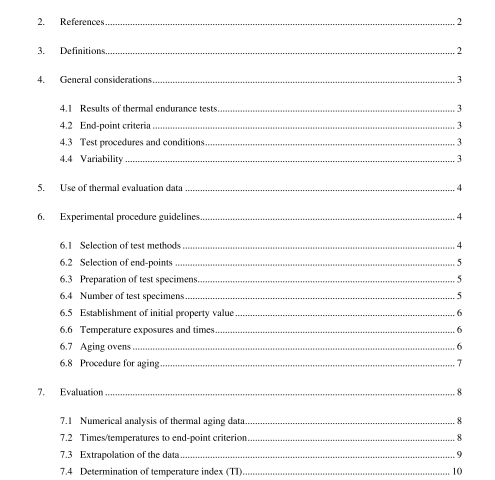IEEE 98-2002 pdf download.IEEE Standard for the Preparation of Test Procedures for the Thermal Evaluation of Solid Electrical Insulating Materials
4. General considerations
The practice to assess the thermal endurance of insulating materials is to age the materials at higher temper- atures than the intended service temperature and to conduct diagnostic tests at ambient temperature to determine retention of properties.
4.1 Results of thermal endurance tests
The results of thermal endurance tests can be described by the Arrhenius relationship between the logarithm of time to a certain degree of property change and the reciprocal of the absolute temperature, K .
This relationship is often used for extrapolating the times to the same degree of property change at lower temper- atures. Performing thermal endurance tests at three or more temperatures serves a double purpose: first, the confidence limits of the extrapolation are improved and, second, a check is provided of the basic assumption that a linear relationship exists between the logarithm of time and the reciprocal absolute temperature.
This linearity may not exist if there is more than one dominant deterioration mechanism in the range of aging temperatures. An extrapolation of the results may not be justified if this check is negative. The aging curve may be extrapolated (see 7.3) to a length of time (usually between 20 000 h and 40 000 h) which is specified in the thermal evaluation procedure for a particular insulating material. The TI for that material is the number that is equal to the value of the temperature obtained from the life-temperature curve at the arbitrarily specified time. The aging curve gives the most complete information about the results of an accelerated thermal aging test. Such curves can also be used to compare materials expeditiously.
4.2 End-point criteria
The TI of the material is determined by end-point criteria based on the material’s ability to withstand stresses such as electric field, mechanical tension, or flexure, etc., or is based on changes in a property of the material. All the properties of a material subjected to heat aging do not deteriorate at the same rate and, consequently, TIs should be obtained for all properties related to possible modes of failure of the material in service. A material may therefore be assigned more than one TI derived from the measurement of different properties
4.3 Test procedures and conditions
Different test procedures have been and are to be developed for different kinds of insulating materials such as impregnating varnishes, sheet insulation, etc. Experience has shown that some insulating materials in combination influence one another during the thermal aging process. This interaction may increase or decrease the relative thermal life compared with the life of either material tested alone. For example, the thermal life of enameled magnet wire may be either increased or decreased, depending upon the insulating varnish used to impregnate windings containing the enameled wire. Metals in contact with insulating materi- als may also affect the thermal aging of the materials. Since insulating materials are often utilized in combination, test procedures may provide for evaluating combinations of materials.
4.4 Variability
It is recognized that insulating materials will be used under widely different conditions. Factors such as voltage stress, irradiation, mechanical shock and vibration, environmental conditioning, and chemical con- tamination shall, therefore, be carefully considered. The test procedure may be modified to provide methods for evaluating the effects of these factors as the material deteriorates thermally. Because materials are used in many different applications and in equipment operating under varying degrees of severity, care shall be taken not to over emphasize any one of these factors.
Experience has shown that the results of thermal endurance tests for comparable insulating materials vary between different manufacturers and from lot to lot. Experience also indicates that thermal degradation often will be more pronounced for some materials when tested in certain shapes or in thin sections. The choice of specimen shape and thickness may, therefore, affect the test results and cause variations that may be greater than variations introduced by slight differences in sample preparation, handling, and test technique. For this reason, rigorous specifications in a test procedure will not prevent variations in test results. More impor- tantly, if requirements that are too strict are specified, the tests may be costly and impractical for general use. In any case, the test method should give reliable results consistent with the inherent variations in the material under test and should provide data free from bias of the tester.IEEE 98 pdf download.IEEE 98-2002 pdf download
IEEE 98-2002 pdf download

Leave a Reply